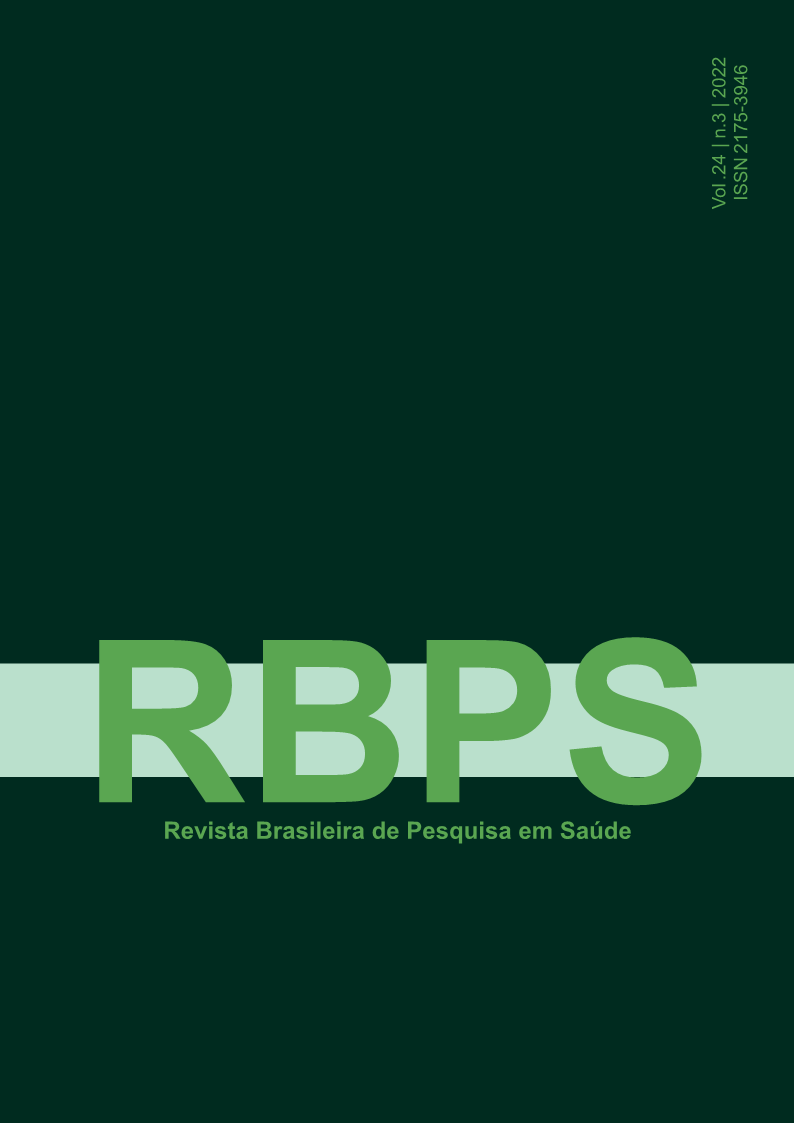Factors associated with congenital malformations among live births in Brazil: SINASC 2017 Data
DOI:
https://doi.org/10.47456/rbps.v24i3.33256Keywords:
Congenital abnormalities, Newborn, Maternal age, EpidemiologyAbstract
Introduction: Congenital malformations are structural or chromosomal problems that significantly affect child development and health. Objectives: To know the prevalence and sociodemographic factors associated with congenital malformations according to the data from the Information System for Life Births (SINASC) of the year 2017. Methods: Cross-sectional study analyzed 2,923,535 live births based on data obtained from SINASC in the year 2017. To assess the outcome, the presence of congenital malformations of newborns at the time of delivery was considered. To test associated factors, sociodemographic variables were considered. Statistical associations were assessed using Poisson regression. Results: The prevalence of congenital malformations was 0.88% (0.87: 0.90) 95% CI. The maternal age, the region of the country, the sex of the newborns and the race / skin color of the mother showed a statistically significant association with the outcome. Conclusion: Knowing the enormous impact that these malformations have, this study is of fundamental importance to help understand and develop measures that enable the prevention of congenital malformations such as, the indispensable role of gynecologists in advising and guiding their patients on the risks of pregnancy in old age, together with policies that fight against gender inequality in the labor market, an interference factor for the choice of maternal age in less secure age groups.
Downloads
References
Rodrigues LS, Lima RHS, Costa LC, Batista RFL. Características das crianças nascidas com malformações congênitas no município de São Luís, Maranhão, 2002- 2011. Epidemiol. Serv. Saúde. 2014;23(2):295-304.
Da Costa TS, Silva MSO, Souza AES, Carvalho ACS, Paiva CEA, Santos KT et al. Perfil epidemiológico das malformações congênitas do sistema nervoso central no estado do Pará, Brasil Epidemiological profile of congenital malformations of the central nervous system in the state of Pará, Brazil. Brazilian Journal of Health Review. 2021;4(1): 2765-2776.
Santos SR, Dias IMAV, Salimena AMO, Bara VMF. A vivência dos pais de uma criança com malformações congênitas. Rev Min Enferm. 2011;15(4):491-7.
Figueiredo SV, Gomes ILV, Queiroz MVO, Mota DDS, Sousa ACC, Vasconcelos CMP. Families’ knowledge about children and adolescents with neural malformation about their rights in health. Esc Anna Nery. 2015;19(4):671-678.
Cunha ACB, Sales EC, Silva PP, de Albuquerque KA. Sobrecarga Emocional ante a Malformação Congênita e o Enfrentamento de Cuidadoras. Revista Psicologia e Saúde. 2021;13(1):141-55.
Brasil. Sistema de Informações sobre Nascidos Vivos (SINASC). Disponível em: https://opendatasus.saude.gov. br/dataset/sistema-de-informacao-sobre-nascidos-vivos-sinasc-1996-a-2020
Cosme HW, Lima LS, Barbosa LG. Prevalência de anomalias congênitas e fatores associados em recém-nascidos do município de São Paulo no período de 2010 a 2014. Revista Paulista de Pediatria. 2017;35:33-8.
Silva JH, Terças ACP, Pinheiro LCB, França GVAd, Atanaka M, Schüler-Faccini L. Perfil das anomalias congênitas em nascidos vivos de Tangará da Serra, Mato Grosso, 2006-2016. Epidemiologia e Serviços de Saúde. 2018;27.
Luz GdS, Karam SdM, Dumith SC. Anomalias congênitas no estado do Rio Grande do Sul: análise de série temporal. Revista Brasileira de Epidemiologia. 2019;22.
Dutra LS, Ferreira AP. Tendência de malformações congênitas e utilização de agrotóxicos em commodities: um estudo ecológico. Saúde em Debate. 2019;43:390-405.
Tellechea AL, Luppo V, Morales MA, Groisman B, Baricalla A, Fabbri C, et al. Surveillance of microcephaly and selected brain anomalies in Argentina: Relationship with Zika virus and other congenital infections. Birth Defects Res. 2018;110(12):1016-26.
Egbe A, Uppu S, Lee S, Stroustrup A, Ho D, Srivastava S. Congenital malformations in the newborn population: a population study and analysis of the effect of sex and prematurity. Pediatr Neonatol. 2015;56(1):25-30.
Fontoura FC, Cardoso MVLML. Association between congenital malformation and neonatal and maternal variables in neonatal units of a Northeast Brazilian city. Texto & Contexto – Enfermagem. 2014;23:907-14.
Gravena AAF, Paula MG, Marcon SS, Carvalho MDB, Pelloso SM. Idade materna e fatores associados a resultados perinatais. Acta Paulista de Enfermagem. 2013;26:130-5.
Bezerra ACL, de Mesquita JS, Brito MCC, dos Santos RB, Teixeira FV. Desafios enfrentados por mulheres primigestas em idade avançada. Revista Brasileira de Ciências da Saúde. 2016;19(2).
Muniz JO, Veneroso CZ. Diferenciais de Participação Laboral e Rendimento por Gênero e Classes de Renda: uma Investigação sobre o Ônus da Maternidade no Brasil. Dados. 2019;62.
Dauffenbach VC, Cavalcante MS, Fernandes EFP, Assami MTC, Silva LM, Silva AMC. Fatores gestacionais e ambientais relacionados à ocorrência de malformações congênitas em região de intensa atividade do agronegócio. Revista Eletrônica Acervo Saúde. 2022;15(6):e10367.
Andrade AM, Ramalho AA, Opitz SP, Martins FA, Koifman RJ. Anomalias congênitas em nascidos vivos. Revista Brasileira em Promoção da Saúde. 2017;30(3).
Costa MAA, Silva FMC, Souza DS. Parceria entre escola e família na formação integral da criança. Rev. Pemo. 2022;1(1):1-14.
Lucena EES, Lima NA, Silva CF, Dos Santos MM, Fernandes TAAM. Perfil Epidemiológico das Malformações Congênitas em Recém-Nascidos no Estado do Rio Grande do Norte no Período de 2004 a 2011. Rev Bras Ciênc Saúde. 2018;22(1):45-50.
Tavares RHF, Barros VA, Sobrinho RRL, Souza MRS, Lopes LG, Neto FLA, et al. Fatores maternos e neonatais relacionados a malformações congênitas no Brasil: um estudo secundário com 2.856.781 gestantes. Brazilian Journal of Case Reports. 2022;2(1):62-74.
Serra SC, Carvalho CA, Batista RFL, Thomaz EBAF, Viola PCAF; Silva AAM; Simões VMF. Fatores associados à mortalidade perinatal em uma capital do Nordeste brasileiro. Ciência & Saúde Coletiva. 2022;7(4):1513- 1524.
Reis LLAS, Ferrari R. Malformações congênitas: perfil sociodemográfico das mães e condições de gestação. Journal of Nursing UFPE/Revista de Enfermagem UFPE. 2014;8(1).
Costa CMS. Perfil das malformações congênitas em uma amostra de nascimentos no município do Rio de Janeiro, 1999-2001 [dissertação]. Rio de Janeiro: Escola Nacional de Saúde Pública. Fundação Oswaldo Cruz; 2005.
Downloads
Published
How to Cite
Issue
Section
License
Copyright (c) 2022 Brazilian Journal of Health Research

This work is licensed under a Creative Commons Attribution-NonCommercial-NoDerivatives 4.0 International License.
Authors and reviewers must disclose any financial, professional, or personal conflicts of interest that could influence the results or interpretations of the work. This information will be treated confidentially and disclosed only as necessary to ensure transparency and impartiality in the publication process.
Copyright
RBPS adheres to the CC-BY-NC 4.0 license, meaning authors retain copyright of their work submitted to the journal.
- Originality Declaration: Authors must declare that their submission is original, has not been previously published, and is not under review elsewhere.
- Publication Rights: Upon submission, authors grant RBPS the exclusive right of first publication, subject to peer review.
- Additional Agreements: Authors may enter into non-exclusive agreements for the distribution of the RBPS-published version (e.g., in institutional repositories or as book chapters), provided the original authorship and publication by RBPS are acknowledged.
Authors are encouraged to share their work online (e.g., institutional repositories or personal websites) after initial publication in RBPS, with appropriate citation of authorship and original publication.
Under the CC-BY-NC 4.0 license, readers have the rights to:
- Share: Copy and redistribute the material in any medium or format.
- Adapt: Remix, transform, and build upon the material.
These rights cannot be revoked, provided the following terms are met:
- Attribution: Proper credit must be given, a link to the license provided, and any changes clearly indicated.
- Non-Commercial: The material cannot be used for commercial purposes.
- No Additional Restrictions: No legal or technological measures may be applied to restrict others from doing anything the license permits.

























